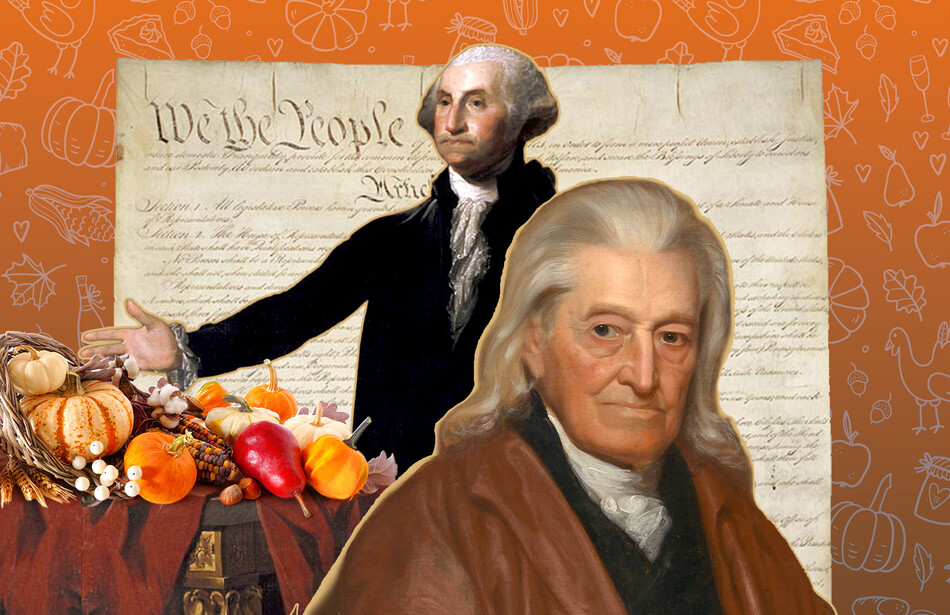On Monday, September 28, 1789, in the US capital of New York, William Samuel Johnson, the first president of Columbia College, paid a visit to George Washington, the first President of the United States. The American project was underway — an “experiment entrusted to the hands of the American people” as Washington said in his inaugural address five months before — and Johnson was on an errand of unity for the fractious, fledgling republic.
In addition to his duties as president of Columbia, Johnson, sixty-one, was a lawyer and senator from Connecticut. Earlier that day, in Federal Hall, a three-story building on Wall Street that was home to the first Congress, Johnson and his colleagues voted on a resolution that Elias Boudinot, a representative from New Jersey, had put forth. The resolution called for “a day of public thanksgiving and prayer to be observed by acknowledging, with grateful hearts, the many signal favors of Almighty God, especially by affording them an opportunity peaceably to establish a Constitution of government for their safety and happiness.”
Days of thanksgiving — for a good harvest or in times of battle — could be found in every culture throughout history, including in the former colonies, but not everyone in Federal Hall loved the idea of this one. Thomas Tudor Tucker, for instance, a congressman from South Carolina, opposed the Constitution on the grounds that it ceded too much power to the federal government, and did not think the president should demand gratitude for it until the people “have experienced that it promotes their safety and happiness.”
Johnson himself had mixed feelings about the Constitution. Like many of the fifty-five delegates present at the Constitutional Convention in Philadelphia in 1787, he regretted that it lacked a bill of rights (the first ten amendments, or Bill of Rights, would be passed in 1791), but he supported the charter’s roadmap for a strong central government that would protect small states like Connecticut from the bigger states.
Known for his intelligence, wisdom, and calm, dignified manner, Johnson mediated interstate disagreements and sought compromise, and when the Constitution was finally adopted, he served as chairman of the Committee of Style, a group that included Gouverneur Morris 1771KC (a former New York congressman and author of the Constitution’s preamble, which begins “We the People”), James Madison (a congressman from Virginia), Rufus King (a senator from Massachusetts), and former King’s College student and Columbia College trustee Alexander Hamilton 1788HON, soon to become the first Secretary of the Treasury. The committee, under Johnson, polished the final draft.
Though a patriot, Johnson was more diplomat than firebrand. In the 1760s he had been a staunch critic of British interference in American colonial affairs, but disliked the radicalism on both sides of the growing conflict, and when the American Revolutionary War (1775–1783) broke out, he was neutral. He also had strong British ties: he was the son of Anglican minister and educator Samuel Johnson, the first president of King’s College, as Columbia was called before the war, and between 1767 to 1771 the younger Johnson had lived in London, working on the legal case to preserve the autonomy granted the Connecticut colony in a 1662 royal charter. He was interested in British politics and passionate about English literature.
But once the colonists prevailed, Johnson was all in. Now, in Federal Hall, he voted Yea on Boudinot’s thanksgiving resolution. The motion passed both Houses, and Johnson was named to a five-man committee charged with delivering it to the President.
And so while his Columbia students sat at desks a short trot away at College Hall (located near today’s City Hall Park), learning Latin, science, and philosophy, Johnson traveled over the cobblestones of Lower Manhattan to the President’s office at 1 Cherry Street.
Washington received the resolution, and on October 3rd, he issued his first proclamation as president, which named November 26th, 1789 as a day “to be devoted by the People of these States to the service of that great and glorious Being, who is the beneficent Author of all the good that was, that is, or that will be.” The President called on Americans to “unite in rendering unto Him our sincere and humble thanks … for the peaceable and rational manner, in which we have been enabled to establish constitutions of government for our safety and happiness, and particularly the national One now lately instituted.”
As the first-ever presidential proclamation, Washington’s statement ruffled some feathers. Thomas Jefferson — Washington’s minister to France — bristled at the notion of an American president imposing a religious observance upon the people. To him, such edicts savored of monarchy.
Johnson, a devout Episcopalian who was married with eleven children (seven survived childhood), probably did say prayers that November 26. Indeed, as Johnson’s biographer, the historian and Episcopal clergyman E. Edwards Beardsley, notes in his 1876 book Life and Times of William Samuel Johnson, Johnson emphasized in his addresses to the graduating classes at Columbia “that the first great duty of a man is owed to Heaven, to his Creator and Redeemer.”
The 1789 day of thanksgiving was a one-off — sort of. Other presidents in other years would issue similar calls, for various reasons, but it was President Abraham Lincoln who picked up Washington’s thread: on October 3, 1863, the same date as Washington’s proclamation, in the thick of the Civil War, and after a persistent campaign by the writer Sarah Josepha Hale (who promoted the idyllic image of the 1621 harvest feast in Plymouth, attended by English colonists and members of the Wampanoag tribe, as the “First Thanksgiving”), Lincoln ordered the last Thursday of November to be “a Day of Thanksgiving and Praise to our beneficent Father who dwelleth in the heavens.” In 1941, President Franklin D. Roosevelt signed a bill making “Thanksgiving Day” a federal holiday.
Just months after the Thanksgiving of 1789, the nation’s capital moved from New York to Philadelphia, and the following year Johnson resigned the Senate. He had his hands full in College Hall, where he focused on reconstituting Columbia from the ashes of King’s College and the Revolution. He expanded the curriculum, hired more faculty, and appointed James Kent as the school’s first professor of law.
Declining health led Johnson to retire from Columbia in 1800, and he returned to his birthplace of Stratford, Connecticut. Beardsley records that “the crowning feature in the character of Dr. Johnson was his Christian faith,” and that on his deathbed “he uttered in the end no words but those which evinced a desire for the prosperity of his country and the spread of Christianity.”
Johnson died in 1819 at age ninety-two, in November, the month of the American Thanksgiving. He did not perish on a Thursday, however. More fittingly, he died on a Sunday, and was buried in the Old Episcopal Cemetery in Stratford, alongside his father.



